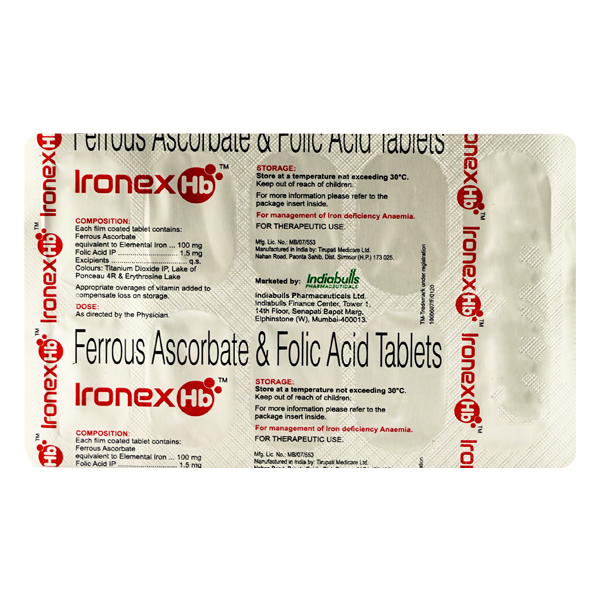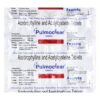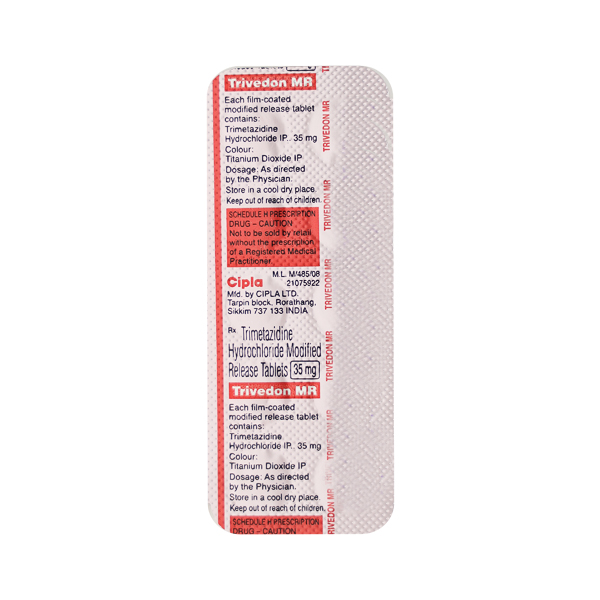Specification
INTRODUCTION
DYSURINE O TABLET is a combination of Flavoxate and Ofloxacin which belongs to the group of medicines called Antispasmodics and Antibiotics respectively. DYSURINE O TABLET is used to prevent or treat urinary tract infections (UTI) and associated problems such as regulating frequency and control of urination in the urinary bladder, prostate gland, urethra and ureter infection. ?
Urinary tract infection (UTI) is an infection in any part of the urinary system, the bladder, kidneys or urethra. It is more common in women and generally occurs in the bladder or urethra, but more serious infections involve the kidney. A bladder infection may cause increased urge to urinate, blood in the urine, pain with urination and pelvic pain. A kidney infection may cause back pain, fever, nausea and vomiting.
Before taking DYSURINE O TABLET, inform your doctor if you have gastrointestinal disease, gastrointestinal bleeding, muscular inability to swallow, urinary retention, myasthenia gravis, glaucoma, epilepsy or tendonitis. ?
DYSURINE O TABLET is not recommended to use among pregnant and breastfeeding women. This medicine is not suitable for use in children and adolescents (under 18 years of age). DYSURINE O TABLET should be used with caution in elderly patients (aged above 60 years). ?
The most common side effect of DYSURINE O TABLET is nausea. Consult your doctor if the side effect worsens over the time. ?
USES OF DYSURINE O TABLET
Treats urinary tract infections (UTIs) and associated urinary incontinence problems
HOW DYSURINE O TABLET WORKS
DYSURINE O TABLET contains flavoxate and ofloxacin. Flavoxate is an antispasmodic that works by relaxing muscles of the urinary bladder and preventing frequent, urgent or uncontrolled urination and relieving the associated pain. Ofloxacin is an antibiotic that acts by killing the bacteria by preventing them from reproducing and repairing themselves.
DIRECTIONS FOR USE
Take DYSURINE O TABLET as advised by your physician. Swallow DYSURINE O TABLET with a glass of water. Do not crush or chew the medicine. Your doctor will decide the correct dose and duration of DYSURINE O TABLET for you depending upon your age, body weight and disease condition.
SIDE EFFECTS OF DYSURINE O TABLET
COMMON
Nausea
UNCOMMON
Sleepiness
Visual impairment
Vomiting, dry mouth, gastric pain and upset stomach (dyspepsia)
Nausea, vomiting, diarrhea or stomach pain
Irritated or burning eyes
Headache, sleep disturbances including difficulty sleeping (insomnia)
Feeling dizzy, having spinning sensations
Agitation, feeling restless
Cough and inflamed sore nose or throat (nasopharyngitis)
Skin rash or itching
RARE
Loss of appetite
Fast heartbeat
Drowsiness
Feeling confused or anxious, seeing, feeling, nightmares or hearing things that are not there, mental illness and depression
Alter in or loss of sense of taste or smell
Shortness of breath or wheezing
Excessive hot flushes and sweating
Lightheadedness or fainting, which may be due to low blood pressure
Rash with pimple
Urinary retention
Fatigue
Stop taking DYSURINE O TABLET and contact your doctor immediately if you experience any of the following side effects:
Severe allergic reactions (such as severe skin rash, swelling of the face, lips, mouth, tongue or throat (angioedema), anaphylactic shock (such as sudden wheezing, swelling of your lips, tongue and throat or body, rash, fainting or difficulties in swallowing
Severe skin rash or allergic reaction
Severe diarrhea (which may be bloody) with stomach pain and fever
Tenderness, pain or restricted movement of the tendons
Blurred, double or altered colour vision
Aortic aneurysm and dissection (symptoms like sudden, severe pain in the abdomen, chest, or back)
Experiencing a rapid onset of shortness of breath, especially when lying down flat in the bed or noticing swelling of ankles, feet or abdomen or new onset of heart palpitations (sensation of rapid or irregular heartbeat)
Sign of pain or inflammation of a tendon (symptoms like ankle, wrist, elbow, shoulder or knee)
Experience symptoms of nerve damage (neuropathy) such as burning, pain, numbness, tingling and/or weakness especially in the feet and legs or hands and arm
HOW TO MANAGE SIDE EFFECTS
Nausea or vomiting:
Try to take DYSURINE O TABLET with or just after a meal or a snack. Stick to simple meals. Avoid eating oil rich or spicy food. Consult your doctor if the symptom gets worse.?
Diarrhea:
Drink lot of fluids such as water to keep yourself hydrated. Try to avoid taking any medicine on your own to treat diarrhoea and consult your doctor if the symptom gets worse.
Headache:
Take rest and drink plenty of water. Avoid taking alcohol and skipping meals. Do not strain your eyes by watching screen for long time. Consult your doctor if the symptom persists for long or gets worsened.
Stomach pain:
Try to rest and relax. Eat and drink slowly or try to have smaller and frequent meals. Keep a heating pad on your stomach. If the symptom does not improve, contact your doctor.
Loss of appetite:
Eat when you are hungry. Eat smaller meals more often than usual. Snack only when you?re hungry. Eat a nutritious snack that is rich in calories and protein such as dried fruit and nuts.
WARNING & PRECAUTIONS
PREGNANCY
DYSURINE O TABLET is not recommended for use in pregnant women. Consult your doctor before taking DYSURINE O TABLET.
BREASTFEEDING
DYSURINE O TABLET is not recommended for use in breastfeeding women. Consult your doctor before taking DYSURINE O TABLET.
DRIVING AND USING MACHINES
Do not drive or operate any machines if you experience sleepiness, dizziness or blurred vision after taking DYSURINE O TABLET.
ALCOHOL
Avoid consumption of alcohol while taking DYSURINE O TABLET.
KIDNEY
DYSURINE O TABLET should be used with caution if you have any kidney problems or impaired kidney function. Consult your doctor before taking DYSURINE O TABLET.
LIVER
DYSURINE O TABLET should be used with caution if you have any liver problems. Consult your doctor before taking DYSURINE O TABLET.
ALLERGY
Do not take DYSURINE O TABLET if you are allergic to Flavoxate or Ofloxacin.
HEART DISEASE
DYSURINE O TABLET should be used with caution in patients with heart disease, endocarditis (an infection of the heart) leaking heart valves (heart valve regurgitation), irregular heartbeat, weak heart (heart failure), history of heart attack and family history of aortic aneurysm or aortic dissection or congenital heart valve disease and prolonged QT interval. Consult your doctor before taking DYSURINE O TABLET.
OTHERS
DYSURINE O TABLET is not recommended for use if you:
Have a gastrointestinal disease that affects the normal passage of food (obstruction)
Have a gastro-intestinal bleeding
Have a muscular inability to swallow (achalasia)
Are not able to completely empty your bladder (urinary retention)
Have glaucoma
Myasthenia gravis (disease which causes general weakness and fatigability of the muscles)
Suffer from epilepsy or are at risk of fits
Have a history of inflammation and swelling of the tendons (tendonitis) (after treatment with a quinolone antibiotic such as ciprofloxacin or norfloxacin)
Have a family history of glucose-6-phosphate dehydrogenase deficiency
Before taking DYSURINE O TABLET, inform your doctor if you:
Have aortic aneurysm or large vessel peripheral aneurysm (enlargement or bulge of a large blood vessel)
Experienced a previous episode of aortic dissection (a tear in the aorta wall)
Connective tissue disorders (Marfan syndrome or Ehlers- Danlos syndrome, Turner syndrome)
Sjogren?s syndrome (an inflammatory autoimmune disease)
Vascular disorders (such as takayasu arteritis, giant cell arteritis)
High blood pressure or atherosclerosis
Rheumatoid arthritis (disease of the joints)
Ever had a history of mental illness
Salt imbalance in the blood (particularly low levels of potassium or magnesium in the blood)
Are diabetic or suffer from low blood sugar
Use in pediatrics:
DYSURINE O TABLET is not suitable for use in children and adolescents (under 18 years of age). Consult your child?s doctor for advice.
Use in geriatrics:
DYSURINE O TABLET should be used with caution in elderly patients (aged above 60 years). Consult your doctor before taking DYSURINE O TABLET.
INTERACTIONS
A. Drug-Drug interactions:
Before taking DYSURINE O TABLET, inform your doctor, if you are taking any of the following medicines:
Medicines used to treat arrhythmias (Ex. hydroquinidine, quinidine, disopyramide, amiodarone, dofetilide, sotalol, ibutilide)
Medicine used to treat depression (Ex. tricyclic antidepressants such as clomipramine and amitriptyline)
Antimicrobials (Ex. macrolides such as erythromycin, clarithromycin, azithromycin, fluoroquinolone such as ciprofloxacin, norfloxacin)
Medicines used to treat some mental health conditions such as schizophrenia and bipolar disorder (Ex. aripiprazole, olanzapine)
Medicines or dietary supplements that contain iron (for anemia) or zinc
Medicine used for stomach ulcers and indigestion (Ex. antacids that contain magnesium or aluminum, sucralfate and cimetidine)
Medicine used to treat inflammation and swelling or over-active immune system (Ex. corticosteroids such as prednisone)
Medicines used as painkillers called non-steroidal anti-inflammatory drugs (NSAIDs) (Ex. ibuprofen or diclofenac)
Medicine used to treat asthma or chronic obstructive pulmonary disease (Ex. theophylline)
Medicine used to treat control blood sugar (Ex. glibenclamide)
Medicine used to treat gout (Ex. probenecid)
Medicines used to treat rheumatism (Ex. methotrexate)
Medicines used to thin blood (Ex. warfarin)
Medicine used to treat HIV infection (Ex. didanosine)
Medicines used as diuretics such as furosemide (used to treat fluid retention)
Overdosage:
If you or anyone else accidentally take too much of this medicine, consult your doctor immediately or visit the nearby hospital. Overdosage symptoms of DYSURINE O TABLET are confusion, dizziness or loss of consciousness, nausea, seizures or fits. ??
SYNOPSIS
Drug :?? Flavoxate, Ofloxacin
Pharmacological Category :?? Anticholinergics, Fluoroquinolone antibiotics
Therapeutic Indication :?? Urinary tract infections (UTI) and its symptoms
Dosage Forms :?? Tablet
MORE INFORMATION
Keep DYSURINE O TABLET out of reach of children
Store DYSURINE O TABLET at room temperature
FAQs ABOUT DYSURINE O TABLET
Q: What precaution to be taken if an overdose of DYSURINE O TABLET is taken?
A: If you or anyone else accidentally take too much of DYSURINE O TABLET, consult your doctor immediately or visit the nearby hospital. Overdosage symptoms of DYSURINE O TABLET are confusion, dizziness or loss of consciousness, nausea, seizures or fits. ???
Q: Can I stop DYSURINE O TABLET if my condition improves?
A: Do not stop taking DYSURINE O TABLET without consulting with your doctor, even if you feel your condition is improved. Stopping may worsen the condition or increase the chance of recurrence.
Q: How does DYSURINE O TABLET work?
A: DYSURINE O TABLET contains flavoxate and ofloxacin. Flavoxate is an antispasmodic that works by relaxing muscles of the urinary bladder and preventing frequent, urgent or uncontrolled urination and relieving the associated pain. Ofloxacin is an antibiotic that acts by killing the bacteria by preventing them from reproducing and repairing themselves.
Q: Is DYSURINE O TABLET safe to use in patients with kidney problems?
A: DYSURINE O TABLET should be used with caution if you have any kidney problems or impaired kidney function. Your doctor may monitor your kidney function test during or after treatment to prevent the risk of any unusual effects. Consult your doctor before taking DYSURINE O TABLET.
Q: What happens if I forget to take a dose of DYSURINE O TABLET?
A: If you miss a dose of DYSURINE O TABLET, take it as soon as possible. However, if it is almost time for your next dose, skip the missed dose and go back to your regular schedule. Do not double the dose to match up for the missed dose.
REFERENCES
1. Conan MacDougall. Sulfonamides, Trimethoprim-Sulfamethoxazole, Quinolones, and Agents for Urinary Tract Infection. Goodman & Gilman?s: The Pharmacological basics of Therapeutics. 13th Edition. New York McGraw Hill Medical 2018. Page ? 1012-1021
2. P Sweeney 1, S Mutambirwa, N Van An, J B Sharma, P Vanamail. Flavoxate in the symptomatic treatment of overactive bladder: a meta-analysis. European Review for Medical and Pharmacological Sciences. September 2015. [Accessed on 3rd June 2022] https://pubmed.ncbi.nlm.nih.gov/27649675/
3. D Arcaniolo 1, S Conquy, T Tarcan. Flavoxate: present and future. European Review for Medical and Pharmacological Sciences. September 2015. [Accessed on 3rd June 2022] https://pubmed.ncbi.nlm.nih.gov/25807422/
4. D. Henry, W. Ellison, J. Sullivan, D. L. Mansfield, D. J. Magner, M. B. Dorr, G. H. Talbot. Treatment of Community-Acquired Acute Uncomplicated Urinary Tract Infection with Sparfloxacin versus Ofloxacin. Journal of Antimicrobial Agents and Chemotherapy. September 1998. [Accessed on 3rd June 2022] https://www.ncbi.nlm.nih.gov/pmc/articles/PMC105806/
5. Recordati Pharmaceuticals Limited. Electronic Medicines Compendium (EMC). [Revised in April 2020]. [Accessed on 3rd June 2022] https://www.medicines.org.uk/emc/files/pil.322.pdf
6. Mylan laboratories. Electronic Medicines Compendium (EMC). [Revised in November 2021]. [Accessed on 3rd June 2022] https://www.medicines.org.uk/emc/files/pil.8481.pdf
USEFUL DIAGNOSTIC TESTS
Urine routine and culture tests
PRODUCT DETAILS
Net Qty
1 N
Item Weight
17.5 g
Ingredient
FLAVOXATE 200 mg+OFLOXACIN 200 mg
Hsn Code
30049099
Show more
Additional information
Weight
17.5 g
Only logged in customers who have purchased this product may leave a review.
Reviews
There are no reviews yet.






















Reviews
There are no reviews yet.